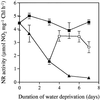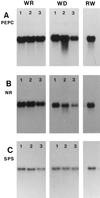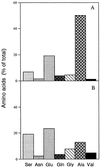Drought-induced effects on nitrate reductase activity and mRNA and on the coordination of nitrogen and carbon metabolism in maize leaves
- PMID: 9576798
- PMCID: PMC35013
- DOI: 10.1104/pp.117.1.283
Drought-induced effects on nitrate reductase activity and mRNA and on the coordination of nitrogen and carbon metabolism in maize leaves
Abstract
Maize (Zea mays L.) plants were grown to the nine-leaf stage. Despite a saturating N supply, the youngest mature leaves (seventh position on the stem) contained little NO3- reserve. Droughted plants (deprived of nutrient solution) showed changes in foliar enzyme activities, mRNA accumulation, photosynthesis, and carbohydrate and amino acid contents. Total leaf water potential and CO2 assimilation rates, measured 3 h into the photoperiod, decreased 3 d after the onset of drought. Starch, glucose, fructose, and amino acids, but not sucrose (Suc), accumulated in the leaves of droughted plants. Maximal extractable phosphoenolpyruvate carboxylase activities increased slightly during water deficit, whereas the sensitivity of this enzyme to the inhibitor malate decreased. Maximal extractable Suc phosphate synthase activities decreased as a result of water stress, and there was an increase in the sensitivity to the inhibitor orthophosphate. A correlation between maximal extractable foliar nitrate reductase (NR) activity and the rate of CO2 assimilation was observed. The NR activation state and maximal extractable NR activity declined rapidly in response to drought. Photosynthesis and NR activity recovered rapidly when nutrient solution was restored at this point. The decrease in maximal extractable NR activity was accompanied by a decrease in NR transcripts, whereas Suc phosphate synthase and phosphoenolpyruvate carboxylase mRNAs were much less affected. The coordination of N and C metabolism is retained during drought conditions via modulation of the activities of Suc phosphate synthase and NR commensurate with the prevailing rate of photosynthesis.
Figures







Similar articles
-
Overexpression of nitrate reductase in tobacco delays drought-induced decreases in nitrate reductase activity and mRNA.Plant Physiol. 1998 May;117(1):293-302. doi: 10.1104/pp.117.1.293. Plant Physiol. 1998. PMID: 9576799 Free PMC article.
-
Growth of tobacco in short-day conditions leads to high starch, low sugars, altered diurnal changes in the Nia transcript and low nitrate reductase activity, and inhibition of amino acid synthesis.Planta. 1998 Dec;207(1):27-41. doi: 10.1007/s004250050452. Planta. 1998. PMID: 9951717
-
Adaptations of Photosynthetic Electron Transport, Carbon Assimilation, and Carbon Partitioning in Transgenic Nicotiana plumbaginifolia Plants to Changes in Nitrate Reductase Activity.Plant Physiol. 1994 Jan;104(1):171-178. doi: 10.1104/pp.104.1.171. Plant Physiol. 1994. PMID: 12232070 Free PMC article.
-
Negative regulation of nitrate reductase gene expression by glutamine or asparagine accumulating in leaves of sulfur-deprived tobacco.Planta. 2000 Sep;211(4):587-95. doi: 10.1007/s004250000322. Planta. 2000. PMID: 11030559
-
[Research advance in nitrogen metabolism of plant and its environmental regulation].Ying Yong Sheng Tai Xue Bao. 2004 Mar;15(3):511-6. Ying Yong Sheng Tai Xue Bao. 2004. PMID: 15228008 Review. Chinese.
Cited by
-
Developmental stage- and concentration-specific sodium nitroprusside application results in nitrate reductase regulation and the modification of nitrate metabolism in leaves of Medicago truncatula plants.Plant Signal Behav. 2013 Sep;8(9):e25479. doi: 10.4161/psb.25479. Epub 2013 Jun 24. Plant Signal Behav. 2013. PMID: 23838961 Free PMC article.
-
Sucrose phosphate synthase (SPS), sucrose synthase (SUS) and their products in the leaves of Miscanthus × giganteus and Zea mays at low temperature.Planta. 2020 Jul 16;252(2):23. doi: 10.1007/s00425-020-03421-2. Planta. 2020. PMID: 32676847 Free PMC article.
-
iTRAQ-based quantitative proteome analysis insights into cold stress of Winter Rapeseed (Brassica rapa L.) grown in the field.Sci Rep. 2021 Dec 6;11(1):23434. doi: 10.1038/s41598-021-02707-z. Sci Rep. 2021. PMID: 34873178 Free PMC article.
-
The crucial role of plant mitochondria in orchestrating drought tolerance.Ann Bot. 2009 Feb;103(4):581-97. doi: 10.1093/aob/mcn094. Epub 2008 Jun 13. Ann Bot. 2009. PMID: 18552366 Free PMC article. Review.
-
The Role of Gibberellins in Regulation of Nitrogen Uptake and Physiological Traits in Maize Responding to Nitrogen Availability.Int J Mol Sci. 2020 Mar 6;21(5):1824. doi: 10.3390/ijms21051824. Int J Mol Sci. 2020. PMID: 32155833 Free PMC article.
References
-
- Becker TW, Foyer CH, Caboche M. Light regulated expression of the nitrate-reductase and nitrite-reductase genes in tomato and in the phytochrome-deficient aurea mutant of tomato. Planta. 1992;188:39–47. - PubMed
-
- Beyrouty CA, Grigg BC, Norman RJ, Wells BR. Nutrient uptake by rice in response to water management. J Plant Nutr. 1994;17:39–55.
-
- Bradford MM. A rapid and sensitive method for the quantitation of microgram quantities of protein utilising the principle of protein-dye binding. Anal Biochem. 1976;72:248–254. - PubMed
LinkOut - more resources
Full Text Sources
Other Literature Sources

